LEGENDRY
PAIR
SANTOSH
& SABIHA |
Nobility
of screen manners |
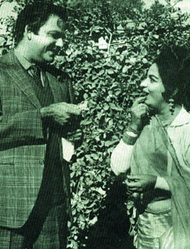 |
A
remarkable nobility of looks and manners marked the screen presence
of Santosh Kumar. When he met the screen queen of the 1950s, Sabiha,
who was known for her vivacity and beauty, it was a rare combination
that lit up the screen. They first worked together in the first
film Santosh did in Pakistan, which was Masood Parvez’s Beli
in 1950s. But, it was actually Anwar Kamal Pasha’s Do Aansoo,
the same year that launched the pair in the cine-circuit of the
country. Later, they did many hit films together, namely Ghulam,
Qatil, Inteqam, Hamida, Sarfarosh, Ishq-e-Laila, Wadah, Saat Lakh,
Hasrat, Moseeqar, Daman etc. But it is said that during the making
of Hasrat in 1958, they got married. The Sabiha-Santosh pair was
a symbol of the pure and earthy elements, enriching an atmosphere
that was essentially classical, and while they looked the part also
in |
the
village atmosphere, with folk songs like Baghon mein bahaar aai in Hasrat,
their true brilliance is revealed in the ritually romantic excellence
of films like Wadah, Qatil and Moseeqar, intermingling the ideal family
saga with ecstatic lift of semi classical music. Although
Santosh and Sabiha did as well in films like Sarfarosh and Sardar, they
seemed more at ease in purely romantic flicks set in the village-meets-city
tales. The fine tuned performances that they gave consistently were
even praised by the top notch directors across the border.
The
last movies of the pair, of course, as supporting actors, were Anjuman,
Mohabbat and Ik Gunah Aur Sahi. Santosh died on 11th June, 1982, which
also took much screen light out of Sabiha. Although she continued to
play mother to lots of heroes on the celluloid, she wasn’t the
same any more.
DARPAN
& NAYYAR SULTANA |
A
lady killer floored by the lady |
| It’s
definitely interesting to note that when Darpan, the younger brother
of Santosh, moved into-big-time Pakistani cinema, he was exactly
opposite to what Santosh represented with large, hazel eyes, that
almost seemed fluorescent, a rich playboy’s smile and slightly
insensitive delivery. Darpan seemed more of a heart-less lady killer
at first. When you find out that Darpan began his film career with
Amanat in 1950, you’d find it strange that he hardly betrayed
any signs of copying any American, European or Indian cinema giant.
In Hollywood, it was the roaring period of Humphrey Bogard, Sydney
Greenstreet and Clark Gable, while in India Prithvi Raj, Nazeer,
Ashok Kumar, Dilip Kumar and Dev Anand were raging. But Darpan showed
no indications that he followed either of them. In a rough way,
you can say that he probably saw more of Clarke Gable |
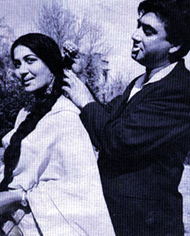 |
than
any other star, because he was the handsomest, hazel-eyed star of Hollywood
in those days!
In
that context, when you analyze how Darpan was attracted to a shy, typically
eastern and an essentially introvert girl, Nayyar Sultana, it is unusual
to say the least. But, it wasn’t a love affair of the screen.
They had met much before they were actually paired for a film, in Sahara.
Darpan looked more the type of Musarrat Nazir (Baap Ka Gunah, Gulfam,
Bahadur) with whom he was paired in many hits. They gelled on the screen
as a couple receptive to each other – he, an eternal romantic
and she, the sex symbol of the 1950s. But eventually when Darpan settled
down in films like Sahehli, Baji and Naela, he was taken seriously by
the average cine-goers as well as the critics. His films with Nayyar,
Shamim Ara and Zeba won credence and that’s also when he soberly
thought of marriage to Nayyar Sultana. People often think about S. M.
Yousaf’s Saheli as the epitome of their career, and in some ways
it is also a pointer towards there sincere love, because Darpan had
found that it was a lady-like Nayyar Sultana he’d settle down
with. The same triangle of Saheli was tried again in S. M. Yousaf’s
Dulhan and S. Suleman’s Tangeywala, but wasn’t as big a
hit as Saheli. It is interesting to note that the Darpan-Nayyar paired
wasn’t really a winning combo on the screen and they were hardly
coupled together on the screen. At the fag end of their career Darpan’s
own Aik Musafir Aik Hasina in 1968 featured them as hero and heroine,
but the film didn’t do too well. Their other films are Azmat,
Meri Bhabi and Saza. Darpan died in the late ‘70s and probably
his last film was Hasan Tariq’s Ik Gunah Aur Sahi. Nayyar Sultana
remained a capable character- actress till mid-1980s and died in the
early 1990s.
EJAZ
& FIRDOUS |
The
legend lives on |
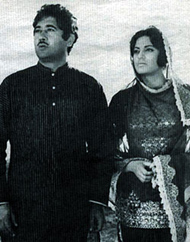 |
There
were just two occasions in the life of Madam Noor Jahan when she
had to keep tabs on her husband Ejaz Durrani! Once, primarily, she
barged in onto the set of Masood Parvez’s Heer Ranjha to watch
whether her personal life hero isn’t too close Firdous, for
comfort! Another occasion was when Shabnam and Ejaz played the lead
in Dosti. But that proved to be false alarm. Of course, for Heer
Ranjha how would Ejaz and Firdous play the legendary lover without
being convincing! It was due to their expressive efforts and true
to life emotions that the legend lives on as a beautiful film. Ejaz
made his debut for Humayyun Mirza’s Bara Aadmi, in 1957 and
followed it up with a thriller, Raaz from Mr. Mirza again. He was
known for his dashing looks and educated background, as well as
attracting the inquiry of the film girls. Mainly chosen for |
Urdu
films, Ejaz did many Punjabi films too, first being Suchche Moti with
Neelo. Firdous, who was usually seen in extra or small roles in films
those days, was thought too awkward for heroine’s status, due
to her towering height and squares bone structure. She made her debut
as the heroine much later than Ejaz, in Khandan in 1964. Later, found
to be an apt replacement to Shireen, in Punjabi films, Firdous quickly
climbed the ladder to reach the top during the 1960s. She became a perfect
heroine for the reigning champ of Punjabi cinema, Akmal in hits like
Heer Sayal, Malangi, and Paidageer etc.
Firdous
and Ejaz come together for the first time in Mirza Jat another folk
tale from Punjab, in 1967. They performed with enough conviction to
make this film by Masood Parvez a hit. The fabulous director then set
to thinking that another folk tale on this pattern would be something
to remember. So, Masood Parvez’s Murad Baloch materialized, with
Firdous and Ejaz now getting intimate. Films like Jawani Mastani, Hameeda,
Dilan De Saudey, Sheran Dee Jorri, Lachchi, Ishq Na Puchche Zaat, Yar
Te Pyar etc, followed within two to three years, with the same leading
cast. Our industry is known for type casting and this was no exception.
But when, in 1970, Masood Parvez again presented his marvelous folk
dastan, called Heer Ranjha, it just took one’s breath away. Both
artistes used to get together in tea breaks and murmured sentences which
were not dialogues. This set the ball rolling. But with revolutionary
minds like Masood Parvez and Khurshid Anwar involved, it was more a
meeting of minds than just an idle love affair. Might be that Noor Jahan
suspected something, but as the film was a major blockbuster, the lady
had to quieten down, to let the pair continue to earn at the box-office.
It was said that Ejaz convinced her that there wasn’t anything
romantic between him and Firdous. So, even after Heer Ranjha they continued
to flourish in films like Banda Bashar, Ishtihari Muzlim, Ik Dhee Punjab
Dee, Banarsi Thag etc. probably Firdous’s last movie, before returning
as character actress in mid 1980s, was Maan Jawani Da in 1976. Ejaz
had already called it a day after Khursheed’s Farz Aur Mamta,
in 1975. He turned to film direction with Punjabi film Sho’lay
in the late 1970s. Firdous, today, has her own family, while Ejaz recently
lost Noor Jahan, in 2000, after almost 35 years of married life.
MOHAMMAD
ALI & ZEBA |
Infinite
grace, timeless integrity |
| If
Pakistani film industry was able to put forward a pair of regal
grace, timeless integrity, expressive brilliance and screen glory
as well as marital blessings, it is the couple called Ali-Zeb. Different
views do continue to exist, but when you see that Mohammad Ali and
Zeba made their debut together for Fazli Sahib’s Chiragh Jalta
Raha, then you must believe that they were destined to rule the
reel and the real life together. Coming down from Radio Hyderabad,
Mohammad Ali became what he was, the premier Pakistani film artiste,
because of his interest in poetry, theatre, vocal delivery and a
most dominating screen presence. It was once said of him that no
film star could match him in expression and body language. That’s
the reason that he drew out the highest accolades from the critics
in films like Aag Ka Darya and Khamosh Raho. Unlike Ali, who played
the villain and smaller roles in many films |
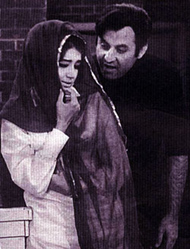 |
before
coming up trumps in Khamosh Raho, Zeba won acclaim immediately after
debut, in films like Jab Se Dekha Hai Tumhein, with Darpan and Dil Ne
Tujihe Maan Liya, with Kamal. Baji followed the same year, in 1963.
So, both the stars were off to good starts to their career. Mohammad
Ali despite a sober, literary background, used to be the most popular
personality among friends and colleague. And female were no exception.
He was quite friendly with his co-stars like Bahar, Shamim Ara, Deeba
and others. So Zeba though a most jovial person herself, found him quite
interesting even on the first day they met. They did many films together
before their marriage, like Head Constable, Rivaj, Kaniz, Jaag Utha
Insan and Waqt Ki Pukar. But after Kaniz, the Ali-Zeb pair was united
forever with marital bonds. And forthwith, S. Suleman launched a film
on a jolly, romantic subject, called Aag. When that proved a hit, another
such film, Jaise Jante Naheen was followed up and was a success too.
Most interestingly, those who point out that the Waheed-Zeb pair was
ultra popular, must also take into account that right after Ali and
Zeba got married, the cine-goers, despite being stunned by the parting
of Waheed and Zeba, gave the newly wedded couple the certificate of
acceptance by making Aag a massive success. Both Doraha and Aag were
released the same year and were both immensely liked. What does that
mean? That the film-goers were essentially moved by good performances
and did not condemn one pair or actor for other. Today our cinema has
lost that viewer due to bad performances. To their credit, Mohammad
Ali and Zeba do not just have a screen presence. They are the only Pakistani
pair, who is revered and honored all over the world, traveling to foreign
countries to be received by dignitaries and being interviewed on BBC
etc.
Apart from churning out hits together during
the ‘60s and ‘70s, like Aag, Jaise Jante Naheen, Baharein
Phir Aaeingee, Dil Diya Dard Liya, Najma, Afsana Zindagi Ka, Mohabbat,
Aurat Ek Paheli, Naukar, Mohabbat Zinndagi Hai, Jab Jab Phool Khilay,
Phool Mere Gulshan Ka, Daman Aur Chingari etc, the Ali-Zeb couple has
remained a duo to be admired for social service and cultural contribution
to the civic life.
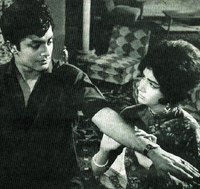 |
It
was as if the world was waiting for them with bated breath. Fewer
pairs in the history of the sub-continental cinema have awakened
such interest and curiosity as Waheed Murad and Zeba. She was senior
to him and had worked with all top heroes of her time, being cast
together with Sudhir (Baghi Sipahi) Darpan Jab Se Dekha Hai Tumhein),
Kamal (Tauba and Ashiana), Mohammed Ali (Head Constable) and Ratan
Kumar (Sameera), before she got a chance to star opposite Waheed
in Parvez Malik’s Heera Aur Patthar, in 1964. She had more
experience, but when they met on the set of Heera Aur Patthar, it
was instant magic. Waheed was a happy-go-lucky Youngman, |
fresh
out of college, with high ideals, and Zeba full of zest and jest, though
blessed with poise on the screen. They exchanged couplets, dialogue,
jokes, anecdotes, what not, and become friends within a few minutes
of their mulaqat. So, it took Parvez Malik to suggest this pair. Before
Heera Aur Patthar, or even after that, other producers and directors
did not have the insight to realize their compatibility. Even after
H aur P succeeded, Waheed was busy working with unequal screen partners
like Naghma (Mamta), Bahar (Doctor) and Sabra Sultana (Bahu Begum).
Only S.M Yousuf cast Waheed with Zeba in Eid Mubarak, in 1965, which
was immensely appreciated. But Arman, in 1966, just changed the screen
scope of the Pakistani cinema. The first Platinum Jubilee hit proved
that the two merged incredibly. Specially, that last scene of Arman,
where they rush into each other’s arms on the popular strains
of Sohail Rana, Akela Na Jana, was the talk of the town. They were stars
of the decade within the 1st day of the release, and people talked about
them as eternal lovers. When they were happy on the screen, the audience
felt they were happy off-screen too. When Waheed had a frown on his
face in Ehsan, for a scene, where Zeba, a widow did not wear his gift,
the cine goers felt the lovers’ tiff crosses over to the real
life. Insaniyat, which portrayed parted lovers, Zeba married to a chronic
patient (not figuratively) Tariq Aziz and Waheed forced by circumstances
to treat him, left a big impression on the people’s minds because
Waheed dies in the tragic film. Ehsan and Rishta Hai Pyar Ka were their
last pictures together, as Mohammed Ali had proposed to Zeba and they
got married. In Kaniz and Jaag Utha Insan, Ali, Zeba and Waheed picturised
scenes side by side, and it was a known fact that Mohammed Ali had proposed
to Zeba during the making of Kaniz, where, by the way, Waheed did the
lead. In an emotional scene, when Waheed slaps Mohammed Ali, the audience
clapped for the hero. Immediately after marriage, Ali and Zeba launched
Aag, while Waheed changed the leading lady in Doraha, and picked Shamim
Ara.
Only
close circles of Waheed know that Shamim Ara was just a replacement.
All the dialogue and songs were for Zeba. Bhooli huee hoon dastan was
an echo of the sad heart. And Haan isse morr par/ iss jagah baith kar
tum ne wadah kiya tha sath do gey zindagi bhar/ chorr kar tum na jaoge
haan issi mor par… what it meant just doesn’t need words
to convey.
Aslam
Parvez and Noor Jehan |
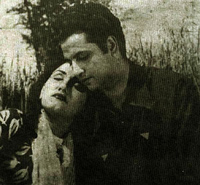 |
The
prince ruled the dreamy kingdom of the films, and the nightingale
sang on till the day she was weighed down with the eternal sleep.
The word will remember Aslam Parvez as the villain in flannelled
slacks and a top hat perched soberly on the forehead. But the man
started off as the Prince charming and in the best of those movies
he was paired of with Madam Noor Jehan. They first crossed paths
in Patey Khan, in 1955, which was an instant hit. Later, in 1958,
they again met in another hit Punjabi flick, Choomantaar. Pardesan
was not so successful. It is incredible to note today that Aslam
played a negative and |
a
positive role opposite Noor Jehan in two films, Neend and Koel, the
same year i.e. 1959, and both proved to be successful. With such big
hits together, it’s strange they were never paired again. That’s
unlike lollywood! Aslam
Parvez, a man with a distinct sense of trendy wardrobe and a vital understanding
of gestures and foot lingo, was a suave male lead, as against an otherwise
sexy, but largely awkward film star, Noor Jehan. The sauce she exuded
was due to her liberal pout, which she maintained till the end, and
even on the censorious Zia-day tube, and those high cheekbones and Kajal-decorated
eyes. She also wore some revealing dresses in her days, including that
one-piece bathing suit on the Clifton beach, in Koel, with Aslam Parvez
by her side. Off the screen, though, Noor Jahan was married to Shukat
Hussain Rizvi and in fact, Aslam Parvez had longer pairing and more
films with Sabiha. So no hint of an off-the screen romance there.
| It
would be hard to say when Nadeeem first met Shabnum, but the first
film he did with her was Suroor Barabankvi’s Tum Mare Ho in
1968. Generally, Nadeem was aired with Shabana, while Rehman was
doing movies with Shabnum. There weren’t too many fans of
the Nadeem-Shabnum pair in East Pakistan then. Everybody like Shabnum
with Nadeem. In fact, Shabnum was already being cast together with
Waheed Murad in Lahore more often during that time. So, Nadeem seldom
had a chance to seriously consider Shabnum as his screen partner.
But his next film with her i.e. Nazneen didn’t do badly, but
Shama Aur Parwana was their first real success in 1970. |
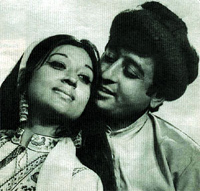 |
After
that, the two stars consistently snuggled close to each other, with
films like Jaley Na Kyun Parwana, Chiragh Kahan Rohni Kahan, Man Kee
Jeet and Ehsas, and that made them a star attraction together. Nadeem’s
motto, slow and steady wins the race, was never lost on the public,
and they loved his consistent quality. This was double the effect when
Nadeem got together with Shabnum. Their respect for each other grew
over the years and their expressive inputs were increased. In the early
1970s, Nadeem was doing more films with Deeba (Sangdil, Aao Pyar Karien,
and Ansoo), Shamim Ara (Suhag, Angarey, Aanch) and Nisho (Bazi, Sehrey
Ke phool). But as time progressed, by the mid 1970’s, Nadeem had
lots of movies with Shabnum, and their pair was established as a symbol
of quality work, like Ehsas, Badal Aur Bijli, Society, Do Badan, Dillagi,
Sharafat etc. Meanwhile, Mumtaz also did some films with Nadeem, which
created a scandal. These discordant notes aside, Nadeem went along pretty
smoothly towards an unassailable position of strength.
In 1977, Aaina was released and created
records of the longest running film and biggest earner of Pakistan history.
After 1977, Nadeem and Shabnum attained a phenomenal rise in fortunes.
Aaina established them for another decade. In the 1980’s, the
pair continued to remain the prime actors of the country, with films
like Bandish, Hum Dono, Qurbani, Dehleez, Kamyabi, Naraz etc.
It was always conjectured that Nadeem and
Shabnum had soft corners for each other, though each of them had married
lives of their own. Nothing concrete is there, in matters of proof that
they over-indulged in any romantic overtures off-screen. Of course,
tea and sympathy is always on the agenda!
Probably
the last film they did together was Javed Fazil’s Faisla, which
also featured Javed Sheikh. It was a massive hit and people still remember
it as the Maula Jat of Urdu films!
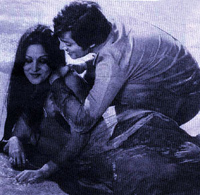 |
Getting
favorable review from the very first movie he did, Waheed Murad
had little time to think of failed films like Saz-o-Awaz, in 1965.
Rani had partnered him in that film on classical music. At that
time, Waheed was excited about the formation of his team which was
making Arman, so Rani; an ordinary, dusky girl was hardly on his
mind. After that, of course, Waheed was totally taken up by his
projects and a charming girl called Zeba. But, when he had gotten
over his tragic parting with her, he started concentrating more
on who he is being cast with. So, when next he crossed path with
Rani, in Hasan Tariq’s Devar Bhabi, he found her to be a very
sensitive girl with |
good
tastes. Although she was a vamps wife in the film, he felt that there’s
a lot more style and body language to Rani than that unimpressive girl
of Saz-o-Awaz. The film did a golden jubilee in 1967. The
next year, he acted in a remarkably light romantic flick with a triangle
comprising of Shamim Ara, Waheed and Rani titled Dil Mera Dharkan Teri.
Their romantic pair was first tired in
Maa Beta in 1969, which did a silver jubilee. But, it took a caliber
director – later her husband Hasan Tariq to realize that only
Rani can do a powerful role in captions of shouldering such a pivotal
role. Yet the way she did that role and showed her bodily perfection
in all sorts of dances, gave her a new image. Waheed’s chocolate
charms had found a perfect magnetic appeal in Rani’s come hither,
voluptuous form. They became the heart and soul of the screen. They
know their cues, both expression-wise and with reference to the body
lingo. Both Waheed and Rani considered Anjuman their best movie. In
the grip of depressive fits, it was Rani who embraced him and gave him
comfort.
After
Anjuman, they did many films together, like Naag Muni Baharo Phool Barsao,
Naag Aur Nagin, Dilruba, Suraiyya Bhopali, Parakh etc. But after the
1970’s things were never the same, as the atmosphere changed in
the studios and both Waheed and Rani became disillusioned before their
eventual departure from the industry, and later untimely deaths.
| Rarely
has the young crowd taken to a young pair in recent times, as it
did with Shaan and Reema in Bulandi. One reason that can be cited
is that they were both real teenagers when they stepped onto the
silver screen. Javed Fazil gave their screen allure the proper settings
to flourish, with an impressive wardrobe, some superb songs and
that special support of the seniors like Nadeem, Samina Peerzada
and Afzal Ahmed that every young artiste needs to blossom. Shaan
and Reema constitute a pair that rarely fails to get noticed. From
Bulandi to Nikah, it’s been a fabulous trek for the two. The
obvious question would be why not the Reema-Babar pair? After all,
there was even a rumor of their marriage once. Babar and Reema had
seven consecutive mega-earners in the 1990’s after they hit
the jackpot with Munda Bigra Jaey. But unless more such hits materialize
form them in the near future; they could be termed a flash in the
pan. Shaan and Reema strike up magic whenever they come together,
as they showed in Nikah. Their star stuff merged in the true sense
of the word despite some lay-offs during their decades-long association,
|
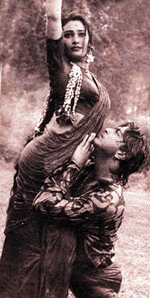 |
they
remain a popular duo. Suring a decade, the two have found different
younger opponents trying to upstage them, but the pair has stuck it
out all this while, with some very fine spectacles of the big screen.
Reema and Shaan won every bout of the match.
Flirts
are in fashion in the films industry. Reema’s affair with Babar
Ali has concrete basis, but her early crush on Shaan was short-lived,
as Madeeha and Reeama vied for screen success, to rope in their only
young hero. Shaan and Reema had numerous hits after Bulandi, but this
time when they came together in Sangeeta’s Nikah, some much needed
maturity had turned their wheels towards superstardom and they remain
the top stars of the cinema in Pakistan.
About eleven years down the lane, Reema
has developed into a super-glossed, electrifying artiste; who livens
up the screen as nobody else. She retains her charisma and jollity,
despite some very bitter happenings in her life and career. Reema has
traveled far and wide in the world and has done films, international
ad-projects, visited world film festivals and has appeared on the reputed
pedestals of Antakshri and Bollywood Awards. Shaan, who has grown sober
and goals-oriented over the years, has consistently taken up big challenges
in life and career and has accomplished some of them, by directing two
above-average movies. His acting potentials has multiplied exceedingly
well, and perhaps if he keeps away from exhausting himself in action-packed
Punjabi films, he would get more room for artistic ventures.
The question that pops up is why we don’t
see Reema and Shaan in more films after Nikah. Maybe because ordinary
direction in later films like Dil Pa To Pagal Hai put paid to that idea.
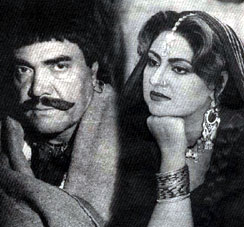 |
Superstars
have often faced this problem that while they march steadily on,
lesser mortals who may be their partners, get old or tired or flopped,
to leave their side. Mega-star, Sultan Rahi faced this dilemma twice
or thrice in his career, not only with his heroine, but with his
opposite number, Mustafa Qureshi. Rahi could never find as brilliant
a Jorridar as MQ, all through the rest of his career. But as far
as heroines are concerned, he was fortunate that when Aasia and
Mumtaz started to fade during the mid-1980, Rahi already had a ready-made
female lead of immense caliber with him. That was Anjuman, who had
ventured successfully into Punjabi movies after her early stint
in Urdu films |
during
the early 1980’s. The film that put her immediately into top gear
was Younus Malik’s Sher Khan in 1981. Sultan Rahi and Anjuman
looked good together. They proved virtual conquerors of the big screen.
Their next films like Sala Saheb, Chan Varyam, Jeedar etc, were all
hits. Anjuman
was gain, a tall Multani specimen of womanhood. Her voice had that special
Khanak and audio level that suited both cinemas, the Urdu and the Punjabi.
She had already looked good with Mohammed Ali in a few Urdu movies,
and then with her typical gestures from Punjabi screen, she just took
lollywood by storm. By this time, Rahi had had some 20 years in the
industry and looked fit for another 20. As Chakori, Mumtaz and Anujuman
were the only heroines on the circuit; Rahi was pried more often with
Anjuman.
Film
actresses in the subcontinent, willingly or unwillingly, are taught
to play up to their heroines. Usually in such cases, an affinity evolves
and sometimes, it leads to romance and affairs. This wasn’t the
case with Anjuman. For ten to twelve years, there wasn’t any stopping
the Rahi Anjuman duo. But in 1990, another Amazonian called Saima entered
the fray and within the next 3 to 4 years, she was rivaling Anjuman
for the number of films she was doing with Sultan Rahi. Moreover, Saima
developed romantic leaning with Rahi and it was rumored that they had
secretly married. Later, the same year, Rahi was killed coming back
from Islamabad, in a car, and as always the murder case was sidelined
because there were big political names involved. Anjuman continued for
sometime but she had grown flabby and lost her popularity so Saima and
the rise of the younger breed like Reema, Meera, Resham and others.
She tried desperately for comeback in 1999, with Chaudhrani, when it
was a hit, but no other film could do the same business. Anjuman is
now lining in London with her Husband.




